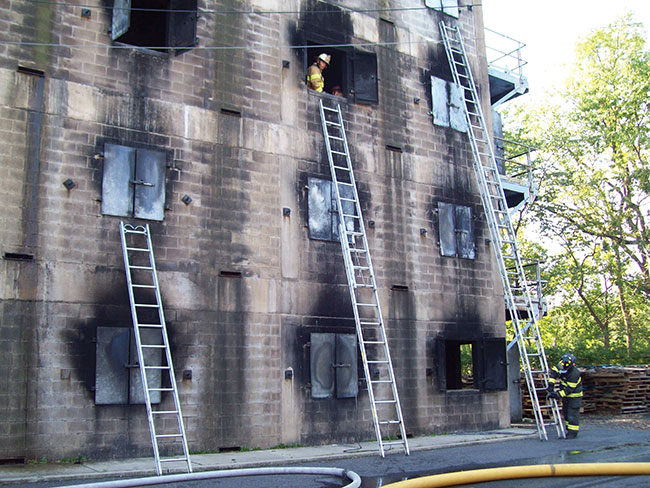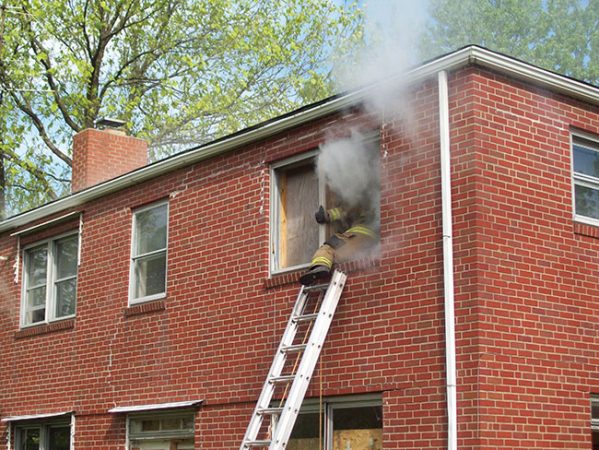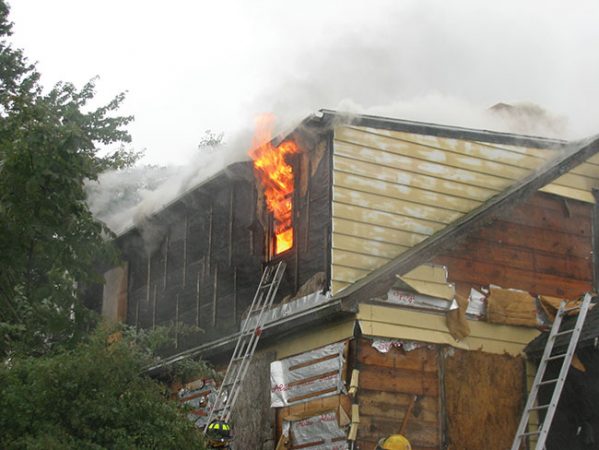
Features
Structural
Training
Back to Basics: Ladder Dating, Part 3
June 1, 2020
By Mark van der Feyst
 Photo 1: Burned building with three different ground ladders staged under three windows. Photos by Mark van der Feyst
Photo 1: Burned building with three different ground ladders staged under three windows. Photos by Mark van der Feyst
Today, every fire truck in service is equipped with two ground ladders: a roof ladder and an extension ladder. Usually the combo set is a 14-foot roof ladder and a 24-foot extension ladder, though this can vary depending upon the specific requirements of the department and truck. Every ladder, regardless of length, has reach limitations so firefighters must know how to work within them.
First, let’s look at the various ladder lengths on firetrucks. For the roof ladder or single section ground ladder, we have access to 14-feet, 16-feet and 18-feet. A roof ladder longer than 18-feet will require a very long fire truck to house it – it’s best to go with a two-section ground ladder than to have an extremely long roof ladder.
Two ground ladders staged side by side (roof and the extension ladder) will be the same length when they are bedded. A 14-foot roof ladder is 14-feet in length. A 24-foot extension ladder is 14 feet in length bedded — when the extension ladder is extended, it then becomes a 24-foot ground ladder. The same is true with the 16-foot roof ladder and the 18-foot roof ladder combinations: a two section 28-foot extension ladder is 16-feet bedded and a two section 35-foot extension ladder is 18-feet bedded.
But why is it important for us to know the bedded lengths of extension ladders?
Every firefighter needs to know ladder math. We can use each ladder to its fullest potential when laddering windows at structures. See photo 1: a burn building with three different ground ladders staged under three windows. All three ground ladders are different: a 14-foot roof ladder going to the second-floor windowsill, the third story window sill ladder with a 24-foot ladder and the fourth story window sill shows a two section 35-foot ladder.
Here are some numbers to keep in mind:
- Average height between two floors in a residential building is 10-feet
- Average height from floor to windowsill is 3-feet
- The ladder tip drops 1 foot for every four feet the butt is pulled away from the building
- This means a 14-foot roof ladder can be used to ladder a second story window
If this seems too good to be true, then let’s look at photo 2: a ground ladder resting below the windowsill ledge. If you look closely at the image, you will notice that it is a 24-foot, two section ground ladder which, when bedded, is only 14-feet in length. The ladder at the window is bedded so it was able to reach the second story window without being extended.
Most firefighters, when asked to ladder a window, will automatically grab the two-section ground ladder thinking they will need to extend it when all they need is the roof ladder. This means, every fire truck arriving on scene has the ability to ladder two windows on each side of a structure using only their roof and extension ladder.
In photo 3, we see another example of a roof ladder reaching a second story window, only this time, it’s a 16-foot roof ladder. Here, the firefighter needs to size up what they need to ladder first then grab the right ladder for the job. In this example, a 24-foot ground ladder to a second story window without extending the ladder is a waste. If there is a need to go to the roof, or even ladder a third story window, that ladder is committed and new one must be sought out.
Ladder math involvers numbers that individuals must memorize. If it is not done on a regular basis, it will be forgotten about very quickly. So, there is another way that we can use to help determine what ladder is needed for various window heights.
A 24-foot ground ladder has the numbers “2” and “4” and in between those two numbers is the number “3”. So, that means a 24-foot ground ladder will reach a third story window. A 35-foot two section ground ladder has the numbers “3” and “5” with the number “4” in between them. That means a 35-foot two section ground ladder with reach a fourth story window. The 28-foot ground ladder is your hybrid ground ladder which will definitely reach the second and third windows.
A factor to consider when looking at a structure, and sizing it for laddering, is terrain. If there is any sloping land near the wall of the window, you need to factor that into your overall height. A walkout basement, for example, will have a sloping grade at the back of the house – if we need to ladder the second story window, we will need a 24-foot ladder to compensate for the drop in the grade.
It is possible to ladder first-floor windows depending on how high they are from the land. Sloping grades will have a determining factor as well, as the length of your attic ladder available. The attic ladder can be used to ladder the first-floor window along with the roof ladder. Using the roof ladder will have a horizontal angle to it, but will still work and support the weight of the firefighter. Some departments equip their trucks with small A-frame ladders; perfect for this type of application.
The only way to know the ladder’s reach limitations is to practice laddering on a building to see it’s reach. But, don’t take my word for it. Prove it to yourself.
Mark van der Feyst has been in the fire service since 1999 and is currently a full-time firefighter with the WFD. He is an international instructor teaching in Canada, the United States, FDIC and India. He is a local level suppression instructor for the Pennsylvania State Fire Academy and the lead Author of Pennwell’s Residential Fire Rescue book. He can be contacted at Mark@FireStarTraining.com.
Print this page

